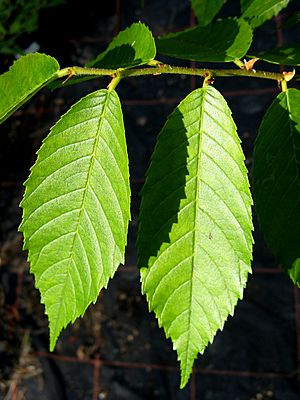Mexican elm facts for kids
Quick facts for kids Mexican elm |
|
|---|---|
 |
|
| Leaves | |
| Conservation status | |
| Scientific classification | |
| Genus: |
Ulmus
|
| Species: |
mexicana
|
| Synonyms | |
|
Chaetoptelea mexicana Liebm. |
|
The Ulmus mexicana, also known as the Mexican elm, is a very tall tree. It grows naturally only in Mexico and Central America. You can usually find it in cloud forests. It also grows in high parts of tropical rainforests. These areas get a lot of rain, about 2 to 4 meters (6.5 to 13 feet) each year.
The Mexican elm grows from San Luis Potosi in Mexico, all the way south to Chiapas. It also grows in countries like Guatemala, Costa Rica, and Panama. Scientists first officially described this tree in 1873.
What Does It Look Like?
The Mexican elm is one of the tallest types of elm trees. It can sometimes reach an amazing height of 84 meters (275 feet)! That's as tall as a 28-story building. Its trunk can be as wide as 2.5 meters (8 feet) across. This makes it one of the tallest trees in Mexico.
The tree has a special gray trunk with deep grooves. Its top part, called the crown, is very full. This dense crown creates a lot of shade below the tree.
The leaves of the Mexican elm can be different sizes. They range from 3 to 16 cm (1 to 6 inches) long. They are 2 to 7 cm (0.8 to 2.7 inches) wide. Their shape can be oval or wider at the top. The top of the leaf is shiny, but the bottom is dull. The small stems that hold the leaves are about 5 to 10 mm long.
This tree has special flowers that grow in clusters. These clusters are up to 7 cm (2.7 inches) long. Each cluster has about 40 perfect flowers. "Perfect" means they have both male and female parts. These flowers do not have petals. The wind helps to spread their pollen. They usually appear between December and February.
After the flowers, small fruits called samaras grow. These samaras are about 9 mm long and 2.3 mm wide. They are covered with long, straight hairs. The tree drops these fruits in March. It is not very easy for new Mexican elm trees to grow naturally from these seeds.
How Do People Use It?
Many of the places where the Mexican elm grows are being cut down. This is called deforestation. However, the tree is not considered in danger of disappearing. This is because people don't often use it for timber. Its deeply grooved trunk makes it hard to cut and process.
The wood of the Mexican elm is hard and heavy. But it is difficult to dry properly. It can also twist and bend a lot as it dries. Also, the wood has a lot of silica, which is like sand. This can damage tools used to cut the wood.
Even with these challenges, the wood is used for some things. People make tools, furniture, and floors from it. The leaves of the tree are also used. Farmers often feed them to their cattle. Sometimes, the tree is planted just for its shade or because it looks nice.
Where Does Its Name Come From?
In Costa Rica, the Mexican elm has a special local name: Tirrá. There is even a neighborhood in Costa Rica named after this tree. It is called Tirrases and is located in Curridabat, San José.
See also
 In Spanish: Olmo mexicano para niños
In Spanish: Olmo mexicano para niños


